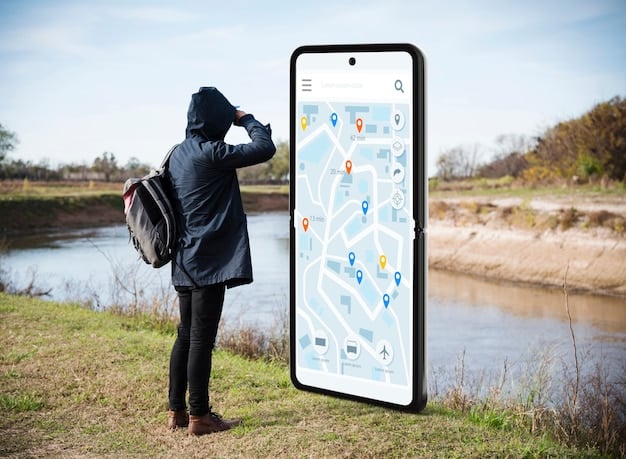Are Neighborhood Watch Programs Still Effective? Crime Prevention in 2025

Neighborhood watch programs, while historically popular, face scrutiny regarding their effectiveness in modern crime prevention, prompting a data-driven examination of their role and impact in 2025.
Are neighborhood watch programs still effective? A data-driven look at 2025 crime prevention reveals a complex landscape where traditional methods are being re-evaluated alongside emerging technologies. Understanding their current role requires examining both the successes and the areas needing improvement.
The Evolution of Neighborhood Watch Programs
Neighborhood watch programs have been a staple of community crime prevention for decades. Originating as simple citizen-led initiatives, they’ve aimed to deter crime through increased vigilance and community engagement. But how have they adapted to the changing face of crime and technology?
Initially, these programs relied heavily on residents patrolling streets, reporting suspicious activities, and fostering a sense of community. Over time, they’ve integrated technology, such as communication apps and security cameras, to enhance their effectiveness. However, the fundamental principles of community involvement and proactive vigilance remain at their core.

Key Components of Traditional Programs
- Increased Surveillance: Residents actively observe and report suspicious activities.
- Community Engagement: Fostering strong relationships among neighbors.
- Communication Networks: Sharing information quickly and efficiently.
- Collaboration with Law Enforcement: Working closely with local police.
Despite their long history, neighborhood watch programs face challenges in the 21st century. Declining participation rates, evolving crime patterns, and technological advancements all necessitate a reevaluation of their effectiveness.
In conclusion, neighborhood watch programs have a rich history of community involvement, but their future depends on adapting to modern challenges and embracing technological innovation to remain effective in crime prevention.
Data-Driven Analysis of Crime Rates in 2025
To assess the effectiveness of neighborhood watch programs, it’s crucial to analyze crime rates and patterns. By examining the data, we can determine whether these programs are making a measurable impact on crime reduction in 2025. But what does the data actually reveal?
Statistical analysis can help correlate the presence of active neighborhood watch programs with changes in crime rates within specific areas. However, it’s important to consider other factors that may influence crime, such as economic conditions, demographic shifts, and law enforcement strategies.
Comparing Areas With and Without Programs
- Crime Rate Comparison: Comparing areas with active programs to those without.
- Incident Reporting: Analyzing the frequency and types of reported incidents.
- Community Perception: Assessing residents’ feelings of safety and security.
Data from 2025 indicates that while some areas with neighborhood watch programs show a decrease in certain types of crime, others do not. This inconsistency highlights the importance of tailoring programs to the specific needs and challenges of each community.
Ultimately, a data-driven analysis provides valuable insights into the impact of neighborhood watch programs, helping communities make informed decisions about their crime prevention strategies. This analysis will ultimately help determine whether these programs are still effective and worth the time and investment required to get them up and running.
The Role of Technology in Modern Watch Programs
Technology is revolutionizing neighborhood watch programs, offering new tools and strategies to enhance their effectiveness. From communication apps to advanced surveillance systems, technology is enabling residents to be more vigilant and responsive to crime. But how exactly is technology changing the game?
Smart home devices, social media platforms, and real-time crime mapping tools are all playing a role in modernizing neighborhood watch efforts. These technologies allow residents to share information quickly, coordinate responses, and stay informed about potential threats.

Examples of Technological Integration
- Mobile Apps: Facilitating instant communication and reporting.
- Security Cameras: Providing visual evidence and deterrence.
- Social Media: Sharing information and coordinating efforts.
- Data Analytics: Identifying crime hotspots and trends.
However, the integration of technology also raises concerns about privacy, security, and accessibility. It’s crucial to address these issues and ensure that technology is used responsibly and ethically to enhance community safety.
In closing, technology is transforming neighborhood watch programs, offering new opportunities to prevent crime and build stronger communities. But the key lies in balancing technological innovation with community values and ethical considerations.
Community Engagement and Participation Rates
Community engagement is the cornerstone of any successful neighborhood watch program. Active participation from residents is essential for creating a strong and vigilant community that can deter crime. But how do we encourage and maintain high levels of engagement?
Declining participation rates are a common challenge for many neighborhood watch programs. Time constraints, apathy, and lack of awareness can all contribute to lower levels of involvement. To counteract this, programs need to be engaging, relevant, and accessible to all residents.
Strategies for Boosting Participation
- Community Events: Organizing social gatherings to foster relationships.
- Online Forums: Creating virtual spaces for communication and collaboration.
- Targeted Outreach: Reaching out to specific demographic groups.
- Incentive Programs: Recognizing and rewarding active participants.
Furthermore, it’s essential to address any barriers to participation, such as language differences, cultural sensitivities, or accessibility issues. By creating a welcoming and inclusive environment, neighborhood watch programs can attract a diverse range of residents and build a stronger community.
To summarize, community engagement is vital for the success of neighborhood watch programs. By implementing targeted strategies and addressing barriers to participation, programs can cultivate a strong and vigilant community that actively works together to prevent crime.
Collaboration with Law Enforcement Agencies
Effective collaboration between neighborhood watch programs and law enforcement agencies is crucial for preventing crime and ensuring community safety. These partnerships can enhance information sharing, coordinate responses, and build trust between residents and police. How do these partnerships work in practice?
By working closely with local police departments, neighborhood watch programs can become valuable extensions of law enforcement efforts. Residents can provide valuable information about suspicious activities, assist in crime prevention initiatives, and help build a stronger sense of community.
Benefits of Strong Partnerships
When neighborhood watch volunteer’s act as extra eyes and ears of their local Police Departments, this strengthens the team:
- Increased Communication: Sharing information quickly and efficiently.
- Coordinated Responses: Working together to address crime incidents.
- Resource Sharing: Leveraging resources to enhance crime prevention efforts.
- Community Trust: Building stronger relationships between residents and police.
However, it’s important to establish clear roles and responsibilities to avoid any misunderstandings or conflicts. Regular communication and training sessions can help ensure that neighborhood watch programs and law enforcement agencies are working together effectively to protect the community.
In short, collaboration with law enforcement agencies is essential for the success of neighborhood watch programs. By fostering strong partnerships and working together, communities can create a safer and more secure environment for all residents.
Addressing Challenges and Measuring Success
Neighborhood watch programs face numerous challenges, from declining participation rates to evolving crime patterns. Overcoming these challenges requires a proactive and adaptive approach. Furthermore, you need to measure success with your watch program. How do you measure success?
One of the biggest hurdles is maintaining consistent engagement from residents. Time constraints, apathy, and lack of awareness can all contribute to lower levels of participation. Programs need to be engaging, relevant, and accessible to all residents to maintain active participation.
Key Performance Indicators (KPIs)
- Crime Reduction: Measuring decreases in crime rates.
- Incident Reporting: Tracking the frequency and types of reported incidents.
- Community Satisfaction: Assessing residents’ feelings of safety and security.
- Program Participation: Monitoring the number of active participants.
Ultimately, addressing challenges and measuring success are crucial for the long-term viability of neighborhood watch programs. By adapting to changing circumstances and focusing on measurable outcomes, programs can continue to play a vital role in preventing crime and building safer communities.
In conclusion, successful neighborhood watch programs need constant measuring and tweaking to make sure they are meeting the needs of the communities they protect. Constant measuring and tweaking is crucial for the long-term viability of the program.
| Key Point | Brief Description |
|---|---|
| 🏘️ Community Engagement | Active participation enhances program effectiveness. |
| 📱 Technology Integration | Mobile apps and cameras improve communication and surveillance. |
| 🤝 Law Enforcement Collaboration | Partnerships enhance crime prevention and response. |
| 📊 Data Analysis | Data helps adjust and improve local crime prevention strategies. |
[Frequently Asked Questions]
▼
Effectiveness varies based on community engagement, technology integration, and collaboration with law enforcement. Data analysis helps measures success.
▼
Technology such as Apps, cameras and social media enhances communications, surveillance, and awareness in preventing crime.
▼
Active community engagement is very important, creating a vigilant community that is willing to deter crime.
▼
They can share info, coordinate how they respond to crime, leverage shared resources to enhance community safety.
▼
Maintaining consistent engagement, addressing privacy concerns, and adapting to new crime patterns is a constant battle.
Conclusion
In conclusion, neighborhood watch programs in 2025 are evolving to meet modern challenges. While traditional methods remain valuable, technology and data-driven strategies are becoming increasingly important. By fostering community engagement, collaborating with law enforcement, and embracing innovation, these programs can continue to play a vital role in preventing crime and building safer neighborhoods.





